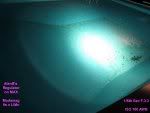This is another review of AlanB's Incan Regulator Sled. Previous review is in this post, but there are just too many pix I took tonight to cram into that Philips 5761 bulb testing thread.
This time we wanted to test Alan's regulator with something a bit more challenging, so I took the venerable Modamag TK Monster as a host, but did it even more beefed up. Instead of 8s x Li-Mn Ion cells as direct drive, I added a 9th for regulated model.
Otherwise it is using the same 64647 250W bulb, with settings in previous link. I had to do a little mod on Modamag's battery holder, and shorten the KIU bulb holder on Alan's sled. Didn't take that long to do, and I took lots of pix. It was one of those foggy New England nights when I went outside.
I pulled myself away from testing JimmyM's PhD regulator (sorry Jimmy), but wanted to get this done and posted, as Alan mentioned in a recent PM that there is a CPF get together tonight with Modamag and Alan attending. I'm just going to post these pix tonight....and can't think of much else to say anyway.
(All pix posted)
This time we wanted to test Alan's regulator with something a bit more challenging, so I took the venerable Modamag TK Monster as a host, but did it even more beefed up. Instead of 8s x Li-Mn Ion cells as direct drive, I added a 9th for regulated model.
Otherwise it is using the same 64647 250W bulb, with settings in previous link. I had to do a little mod on Modamag's battery holder, and shorten the KIU bulb holder on Alan's sled. Didn't take that long to do, and I took lots of pix. It was one of those foggy New England nights when I went outside.
I pulled myself away from testing JimmyM's PhD regulator (sorry Jimmy), but wanted to get this done and posted, as Alan mentioned in a recent PM that there is a CPF get together tonight with Modamag and Alan attending. I'm just going to post these pix tonight....and can't think of much else to say anyway.
(All pix posted)
Last edited:






































